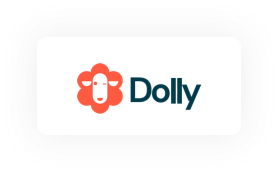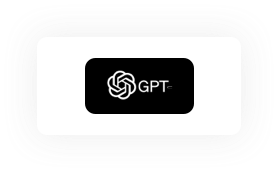Share your requirements and we'll get back to you with how we can help.
Thank you for submitting your request.
We will get back to you shortly.
Harness Large Language Models for Advanced Language Processing
Join the era of large language model-driven innovation with QBurst. Build and integrate LLM-powered applications into existing workflows for more context-aware interactions.

Our Services
Consultation and
Strategy
Our consultants will study your business and identify areas where LLMs can add value, suggest.. a suitable large language model, the fine-tuning required, and the proper point of integration with your existing processes.
Show More
Custom Solution
Development
We develop NLP solutions where the LLMs are fine-tuned on task-specific data to be customized.. for your business. Our experts will assess your workflow to identify the optimal integration points and seamlessly incorporate the solution into your existing applications, tools, or website.
Show More
Prompt
Engineering
Our prompt engineers are skilled in creating prompts that serve as navigational cues for LLMs.. , ensuring that the responses generated are aligned with the specific context and goals of the intended application.
Show More
LLM-Powered Application
Development
From selecting a foundational model to fine-tuning it and hosting and deploying the solution.. , our end-to-end application development service will ensure you get the best out of your LLM-based app.
Show More
Retrieval-Augmented
Generation
RAG-based LLM optimization is the key to building applications that require highly accurate.. domain-specific information. Our experts set up vector databases, optimize context retrieval mechanisms, and design a prompt template that integrates user queries with the retrieved context.
Show More
Open-Source and
Cloud LLM Support
We customize open-source LLMs for specific applications and provide support to set up the hosting.. infrastructure, ensuring scalability and performance. Additionally, for cloud-based LLMs we can implement privacy controls to protect sensitive data.
Show More
Consultation and Strategy
Our consultants will study your business and identify areas where LLMs can add value, suggest a suitable large language model, the fine-tuning required, and the proper point of integration with your existing processes.
Custom Solution Development
We develop NLP solutions where the LLMs are fine-tuned on task-specific data to be customized for your business. Our experts will assess your workflow to identify the optimal integration points and seamlessly incorporate the solution into your existing applications, tools, or website.
Prompt Engineering
Our prompt engineers are skilled in creating prompts that serve as navigational cues for LLMs, ensuring that the responses generated are aligned with the specific context and goals of the intended application.
LLM-Powered Application Development
From selecting a foundational model to fine-tuning it and hosting and deploying the solution, our end-to-end application development service will ensure you get the best out of your LLM-based app.
Retrieval-Augmented Generation (RAG)
RAG-based LLM optimization is the key to building applications that require highly accurate domain-specific information. Our experts set up vector databases, optimize context retrieval mechanisms, and design a prompt template that integrates user queries with the retrieved context.
Open-Source and Cloud LLM Support
We customize open-source LLMs for specific applications and provide support to set up the hosting infrastructure, ensuring scalability and performance. Additionally, for cloud-based LLMs we can implement privacy controls to protect sensitive data.
Large Language Model Use-Cases
NLP
Tasks
- Sentiment Analysis
- Language Translation
- Text Summarization
- Information Extraction
Content
Generation
- Marketing Materials
- Product Descriptions
- Advertisements
- Newsletters
Customer
Service
- Virtual Assistants
- Chatbots
- Recommendation Engines
Information
Retrieval
- Search Engines
- Question-Answering Systems
Large Language Model Operations
Putting a large language model into use involves a series of steps. By meticulously executing them, we can help you effectively leverage LLMs for your use case.
 Data Collection and Preprocessing
Data Collection and Preprocessing
Identify relevant and quality data. Create repeatable, editable, and shareable data sets to iteratively prepare data for product lifecycle. Steps are taken to protect sensitive data.
 Prompt Engineering
Prompt Engineering
Provide instructions, examples, or constraints to ensure that the LLM generates responses that are specific to the application.
 Fine-Tuning
Fine-Tuning
Train using the task-specific dataset. This helps the model adapt its knowledge and learn to generate contextually relevant responses.
 Integration
Integration
Incorporate the LLM into existing systems and workflows using APIs.
 Deployment
Deployment
Whether it's on-cloud, on-premises, or a hybrid solution, we design and configure efficient architectures to ensure scalability, reliability, and resource optimization.
Data Collection and Preprocessing
Identify relevant and quality data. Create repeatable, editable, and shareable data sets to iteratively prepare data for product lifecycle. Steps are taken to protect sensitive data.
Prompt Engineering
Provide instructions, examples, or constraints to ensure that the LLM generates responses that are specific to the application.
Fine-Tuning
Train using the task-specific dataset. This helps the model adapt its knowledge and learn to generate contextually relevant responses.
Integration
Incorporate the LLM into existing systems and workflows using APIs.
Deployment
Whether it's on-cloud, on-premises, or a hybrid solution, we design and configure efficient architectures to ensure scalability, reliability, and resource optimization.
Popular LLMs







LLMs are pre-trained on a large corpus of data that can be used for a wide range of downstream tasks. Depending on your requirements, resources, and bandwidth, we can help you find the one that fits your needs. A quick comparison between open-source and closed-sourced models is provided below:
| Open-Source Models | Closed-Source Models |
|---|---|
| Open-source models, such as StableLM, Llama 2, and XLNet, are freely available for anyone to access and use. | For closed-source models like GPTs, users may be subject to licensing fees or usage restrictions. |
| Open-source models can be hosted locally to ensure that confidential information is not sent to any third parties. | Closed-source models require all data to be sent to third-party servers, which potentially raises concerns about data privacy and security. |
| Open-source models give developers more freedom to diagnose and fix any errors or biases. | Closed-source models are less transparent, which can make it difficult for developers to diagnose and correct biases in them. |
| Open-source models are often more customizable, allowing companies to tailor the models to their specific needs and use cases. | Companies may have less control over the development of closed-source models and may need to invest more resources into customizing them for their specific needs. |
